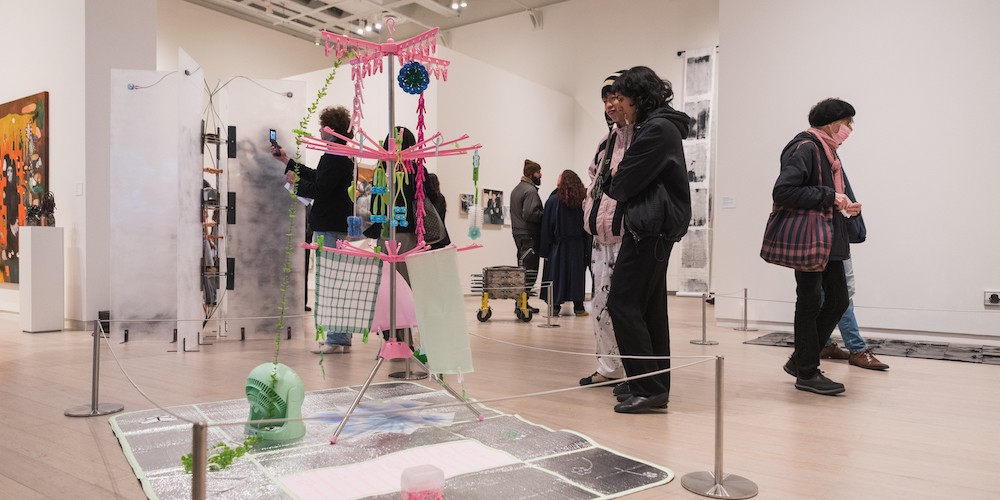Spring Exhibition Highlights 2025 Visual Arts Students
The artists’ mediums spanned ceramics, printmaking, glass, and charcoal—yet the simplicity of these materials belied the deeply innovative and intimate narratives woven into their work. On March 22, 2024, the Columbia University School of the Arts Visual Arts Program held an opening reception to present the 2025 First Year MFA Exhibition in collaboration with the Miriam and Ira D. Wallach Art Gallery at the Lenfest Center for the Arts. The exhibition served as a showcase for the 30 artists who will complete their first year of the Visual Arts MFA Program in May.
First-year Visual Arts student Ridwana Rahman’s artistic practice constitutes an exploration of her own being and a consideration of ritual without spirituality and faith without practice. Rahman’s approach tends to intersect photography, sculpture, and moving images. Her piece, titled Points of Contact (or, Who are you on your hands for?) (2024) includes a low-hanging self-portrait photograph of her body clad in black latex juxtaposed with a series of glazed black tiles made of porcelain. Imprinted with Rahman’s hands and knees in prayer, the tiles reveal the remnants and weight of the artist’s body.
Rahman described the work as an evocation of the performance of prayer, imbued with a sense of voyeurism.
“I’m interested in being able to control the audience,” Rahman said. “To see people get on their hands and knees—to kneel down with their body just to see my image—it reminds me of the power that I hold. I want a level of ambiguity, but I also want a very direct correlation between sex and religion and the photo establishes that.”
Similarly, first-year student Sharon Cheuk Wun Lee explores transmutations between images and materials in her artistic process. Her work often interrogates disappearance and the impossibility of returning to beauty. A sense of longing and loss inspires Lee’s art making, influencing her decision to implement techniques such as repetition and representation and to implicate the state of the invisible.
Lee’s piece, Canton Girl in the Metropolitan Museum of Art (2024), reflects her curiosity about using objects of the past and integrating past identities to look forward to and cast portraits of the future. A black-and-white archival inkjet print on canvas, layered with blue, green, yellow, and red zip ties, the work is based on a nineteenth-century photograph Lee discovered at the Met. The zip ties evoke traditional women’s craftsmanship, Lee explained.
“In the past, people colored photographs. Now, I apply color with zip ties,” Lee said. “Zip ties are problematic on the body in some ways, but in this case, it offers an embroidery quality.”
For Wenhui Quan, the exhibition allowed for an opportunity to interrogate notions of gendered power, and the legacies that uphold and move these societal structures. Quan’s work included a framed Subway map layered beneath a graphite sketch of male genitalia. The map was displayed above a seat made of mattress sponge, printed with closed-eye digital icons.
“I feel the world as a central power,” Quan said. “I’m interested in the story about the central power and the ‘man’s world.’”
Adjunct Associate Professor Baseera Khan made note of the complexity and dedication apparent across the students’ work in the gallery.
“Transformation is a verb,” Khan said. “You have to use materials that transcend. I’m impressed [with] how every single artist transcended their materials.”
The exhibition was curated by Amy Sadao, and ran from March 23, 2024 to April 7, 2024.
